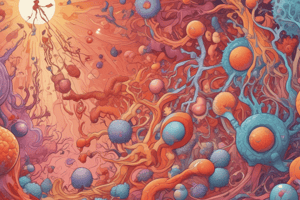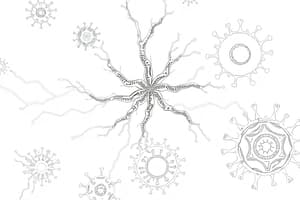Podcast
Questions and Answers
Explain the role of chemokines in leukocyte recruitment to sites of inflammation. How do they differ from other cytokines in their function and action?
Explain the role of chemokines in leukocyte recruitment to sites of inflammation. How do they differ from other cytokines in their function and action?
Chemokines are a sub-group of cytokines that play a crucial role in leukocyte recruitment during inflammation. They act as chemoattractants, attracting leukocytes to the site of inflammation by creating a concentration gradient. Unlike other cytokines, chemokines specifically affect the mobilization of cells, causing them to adhere to endothelial cells, alter their movement, and migrate towards the chemokine gradient. Their structure is characterized by conserved cysteine residues, specifically CC or CXC, which determines their target leukocyte types.
Explain how the interaction between adhesion molecules (ICAMs) and integrins on leukocytes contribute to firm adhesion and diapedesis during inflammation.
Explain how the interaction between adhesion molecules (ICAMs) and integrins on leukocytes contribute to firm adhesion and diapedesis during inflammation.
During inflammation, endothelial cells express ICAMs (intercellular adhesion molecules), which bind to integrins on leukocytes. Initially, the interaction is weak, but cytokines trigger leukocytes to express high-affinity integrins, strengthening the bond. This firm adhesion allows leukocytes to stop and spread, preparing for diapedesis. Diapedesis, the process of leukocytes exiting the bloodstream, is then facilitated by the breakdown of endothelial cell junctions, allowing the leukocytes to pass through the vessel wall into tissue.
Explain the role of TNF and IL-1 in inflammation. How do they contribute to the recruitment and activation of leukocytes?
Explain the role of TNF and IL-1 in inflammation. How do they contribute to the recruitment and activation of leukocytes?
TNF (Tumor Necrosis Factor) and IL-1 (Interleukin-1) are proinflammatory cytokines that play crucial roles in leukocyte recruitment and activation. Released by macrophages and other cells, they trigger endothelial cells to express ICAMs , adhesion molecules that bind to leukocytes. They also induce the expression of chemokines, which attract specific leukocytes to the site of inflammation. Moreover, both TNF and IL-1 enhance the expression of integrins on leukocytes, further strengthening their adherence to endothelial cells, ultimately paving the way for diapedesis and leukocyte accumulation in tissues.
Describe the steps involved in cytokine signaling, starting from the inducing stimulus to the biological effect. How does this signaling cascade contribute to the inflammatory response?
Describe the steps involved in cytokine signaling, starting from the inducing stimulus to the biological effect. How does this signaling cascade contribute to the inflammatory response?
What are the main functions of cytokines in the body? How do these functions contribute to the overall immune response?
What are the main functions of cytokines in the body? How do these functions contribute to the overall immune response?
Describe the process of extravasation during the inflammatory response, highlighting the role of cell adhesion molecules and the specific types of cells involved.
Describe the process of extravasation during the inflammatory response, highlighting the role of cell adhesion molecules and the specific types of cells involved.
Explain how mast cells contribute to the cardinal signs of inflammation, specifically focusing on their role in vasodilation and increased vascular permeability.
Explain how mast cells contribute to the cardinal signs of inflammation, specifically focusing on their role in vasodilation and increased vascular permeability.
Compare and contrast the roles of neutrophils and macrophages in the inflammatory response, highlighting their differences in lifespan, location, and phagocytic activity.
Compare and contrast the roles of neutrophils and macrophages in the inflammatory response, highlighting their differences in lifespan, location, and phagocytic activity.
Explain the role of PRRs and PAMPS in the activation of innate immune cells during the inflammatory response.
Explain the role of PRRs and PAMPS in the activation of innate immune cells during the inflammatory response.
Describe the key differences between the acute and chronic inflammatory responses, providing examples of each.
Describe the key differences between the acute and chronic inflammatory responses, providing examples of each.
Discuss the role of dendritic cells in the inflammatory response, paying particular attention to their function as antigen presenting cells.
Discuss the role of dendritic cells in the inflammatory response, paying particular attention to their function as antigen presenting cells.
Explain how the release of cytokines, chemokines, and histamine contributes to the recruitment of immune cells and the development of the inflammatory response.
Explain how the release of cytokines, chemokines, and histamine contributes to the recruitment of immune cells and the development of the inflammatory response.
Describe the role of complement in the inflammatory response, highlighting its ability to trigger the recruitment of immune cells and its role in pathogen destruction.
Describe the role of complement in the inflammatory response, highlighting its ability to trigger the recruitment of immune cells and its role in pathogen destruction.
Flashcards
Cytokines
Cytokines
Signaling proteins that mediate communication in the immune response.
Diapedesis
Diapedesis
Process of leukocytes moving through endothelial cell junctions into tissues.
Chemokines
Chemokines
Subgroup of cytokines that act as chemoattractants to recruit cells.
Integrin
Integrin
Signup and view all the flashcards
IL-1
IL-1
Signup and view all the flashcards
Inflammatory Response
Inflammatory Response
Signup and view all the flashcards
Cardinal Signs of Inflammation
Cardinal Signs of Inflammation
Signup and view all the flashcards
Neutrophils
Neutrophils
Signup and view all the flashcards
Macrophages
Macrophages
Signup and view all the flashcards
Vasodilation
Vasodilation
Signup and view all the flashcards
Extravasation
Extravasation
Signup and view all the flashcards
Mast Cells
Mast Cells
Signup and view all the flashcards
Study Notes
Inflammatory Response Overview
- The inflammatory response is a cascade of events at the site of infection or injury, characterized by redness, swelling, pain, and heat (cardinal signs).
- It's an acute (short-term) response to infection or a chronic (long-term) response to cell damage (e.g., IBS, arthritis).
Immune Cells in Inflammation
- Neutrophils: Most abundant, circulating blood cells that are phagocytic (engulfing pathogens). They die after ~8 hours.
- Macrophages: Resident cells that are the first to encounter microbes. They also are phagocytic and monocytes differentiate into macrophages at the site of inflammation.
- Dendritic cells: Resident cells that sense danger and release cytokines.
- Mast cells: Resident in skin and mucosal tissues. Activated by PAMPs, cytokines, or antibodies, they release histamine and cytokines, triggering vasodilation and increased capillary permeability.
Inflammatory Response Steps
- Before injury/infection: Monocytes and neutrophils circulate in the blood; resident macrophages, dendritic cells, and mast cells reside in tissues.
- Injury/Infection: Tissue damage, pain, and bacterial entry activate immune cells.
- Activation: Pattern recognition receptors (PRRs) and pathogen-associated molecular patterns (PAMPs) activate innate immune cells.
- Cytokine release: Damaged cells and activated immune cells release cytokines, chemokines, histamine, and bioactive lipids (e.g., TNF, IL-8, IL-1).
- Capillary Alteration: Vasodilation (increased capillary diameter) occurs due to histamine release causing increased vascular permeability (swelling/edema). Increased blood volume and slowed blood flow allow inflammatory mediators to enter tissues.
- Extravasation: Leukocytes (neutrophils, monocytes) exit the bloodstream through a process involving rolling, activation, arrest, and diapedesis facilitated by changes in endothelial cells and the release of chemoattractants.
- Phagocytosis and Wound Clearance: Neutrophils act as the first responders, and monocytes differentiate into macrophages, which provide ongoing protection. Dendritic cells/macrophages present antigens to the adaptive immune system in the lymph nodes.
- Clotting: This also occurs as part of the inflammatory response, but not explicitly detailed in this section.
Inflammatory Mediators: Cytokines
- Cytokines: Communicate between immune cells, affecting cell adhesiveness, enzyme activity, cell survival/death, and gene expression.
- Cytokine Action:
- Stimulus activates cytokine gene expression in a producer cell.
- Cytokines are secreted.
- Cytokine binds to receptors on target cells.
- Cellular signal transduction/activation of specific enzymes and genes.
- Biological effect (proliferation, differentiation, cell death).
- Key Cytokine Types:
- IL-1: Pro-inflammatory, released by macrophages and epithelial cells.
- TNF: Pro-inflammatory, released by macrophages and neutrophils.
- IL-8 (CXCL8): Recruits and activates neutrophils.
- Chemokines: Specific subgroup of cytokines that are chemoattractants; affect cell movement, adhesion, and attraction to inflammation sites. They exhibit a concentration gradient. Many are named based on conserved cysteine residues in their structures (e.g., CC, CXC).
Studying That Suits You
Use AI to generate personalized quizzes and flashcards to suit your learning preferences.
![Lecture 03: Overview of Inflammatory Response in Immunology [SEQ 2]](https://images.unsplash.com/photo-1580795478966-561ba4f1ce68?crop=entropy&cs=srgb&fm=jpg&ixid=M3w0MjA4MDF8MHwxfHNlYXJjaHw1fHxpbmZsYW1tYXRvcnklMjByZXNwb25zZSUyQyUyMGltbXVuZSUyMHN5c3RlbSUyQyUyMGNlbGx1bGFyJTIwYmlvbG9neXxlbnwxfDB8fHwxNzM4NzI5MzYzfDA&ixlib=rb-4.0.3&q=85&w=800&fit=crop&h=300&q=75&fm=webp)


